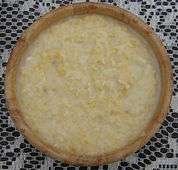Corn stew
Corn stew is a stew prepared with corn (maize) as a primary ingredient. Many variations exist in ingredient usage and in methods of preparation. Corn stew is a dish in several cuisines of the world. Mazamorra is an historically old corn stew dish in South America that is prepared using simple ingredients, and is a dish in several other cuisines.
Overview
Corn is a main ingredient in corn stew. Many variations of corn stew exist. A simple corn stew version consists of corn stewed with milk, butter, flour and salt.[1] Additional ingredients used in corn soups include potato, beans, hominy, creamed corn, carrot, celery, tomato, onion, scallions, garlic, various stocks, butter, salt and pepper[2][3][4] among others. Meats such as chicken, fish, shrimp, sausage and bacon are sometimes included as an ingredient.[4][5][6][7][8][9][10] Some corn stews are prepared using a roux, which creates a thicker consistency and texture.[8] Canned or frozen corn and other canned foods such as tomato are sometimes used to prepare corn stew.[4][8] The flavor of corn stew may improve after a day[8] or more, because aging allows the flavors to intermingle and coalesce with one-another. Corn stews generally have a thicker consistency compared to corn soups.
In cuisines
Corn stew is a dish several cuisines, including the cuisine of the Southern United States, Cajun cuisine, Native American cuisine, such as among the Hopi tribe, and South American cuisine,[8][11][12][13] among others.
Mazamorra
The dish mazamorra is a historically old corn stew dish among the indigenous peoples in South America that is simple to prepare, consisting primarily of dried cracked corn and water.[12] The kernels are typically pounded to break them down into smaller pieces.[12] Depending upon the region, white or yellow corn may be used.[12] The term "mazamorra" itself originates from native peoples in South America.[14] Mazamorra and variations of the dish is a part of the cuisine of Brazil,[12] Chile, Colombia, Paraguay, Peru and Venezuela,[12] and in Costa Rica and Puerto Rico. In South American cuisine, mazamorra morada is a sweet version of the dish prepared using blue corn and berries.[14]
 Mazamorra with milk, in Argentina
Mazamorra with milk, in Argentina
See also
| Wikimedia Commons has media related to Corn stew. |
- Corn chowder
- List of maize dishes
- List of stews
- Succotash, a food dish consisting primarily of sweet corn with lima beans or other shell beans
References
- ↑ Murphy, C.J. (1890). Lecture Delivered by Charles J. Murphy. R. Grant & Son. p. 66. (Delivered before the National Agricultural Society of France, at the International Congress of Millers, Held at Paris in August, 1889, on American Indian Corn (maize) as a Cheap, Wholesome, and Nutritious Human Food)
- ↑ Carroll, Mary (January 1996). "Don't Stew Over Dinner". Vegetarian Times. p. 34. Retrieved 11 December 2015.
- ↑ Emmons, D. (1997). Vegetarian Planet. Harvard Common Press. p. 473. ISBN 978-1-55832-115-1.
- 1 2 3 The Slow Cook Book. DK Publishing. 2011. p. 270. ISBN 978-0-7566-8944-5. Retrieved December 11, 2015.
- ↑ Hulin, B. (2009). The Everything Soup, Stew, and Chili Cookbook. F+W Media. p. 196. ISBN 978-1-4405-2113-3.
- ↑ "Old-Fashioned Chicken and Corn Stew". Epicurious. August 20, 2004. Retrieved December 11, 2015.
- ↑ Tartan, B. (1992). North Carolina and Old Salem Cookery. Chapel Hill Bks. University of North Carolina Press. p. 129. ISBN 978-0-8078-4375-8.
- 1 2 3 4 5 Link, D.; Disbrowe, P. (2012). Real Cajun: Rustic Home Cooking from Donald Link's Louisiana. Potter/TenSpeed/Harmony. pp. 113–115. ISBN 978-0-7704-3420-5. Retrieved December 11, 2015.
- ↑ Hesser, A. (2010). The Essential New York Times Cookbook: Classic Recipes for a New Century. W. W. Norton. pp. 538–539. ISBN 978-0-393-24767-1. Retrieved December 11, 2015.
- ↑ Ritchie, T.; Fink, B. (2012). Braises and Stews: Everyday Slow-Cooked Recipes. Chronicle Books LLC. p. 105. ISBN 978-1-4521-2505-3.
- ↑ Stephens, B. (2014). The New Southern Table: Classic Ingredients Revisited. Fair Winds Press. p. 104. ISBN 978-1-59233-585-5.
- 1 2 3 4 5 6 Kijac 2003, p. 282.
- ↑ Kavena, J.T. (1980). Hopi Cookery. University of Arizona Press. p. 69. ISBN 978-0-8165-0618-7.
- 1 2 Kijac 2003, p. 132.
Bibliography
- Kijac, M.B. (2003). The South American Table. NYM Series. Harvard Common Press. ISBN 978-1-55832-249-3. Retrieved December 11, 2015.
